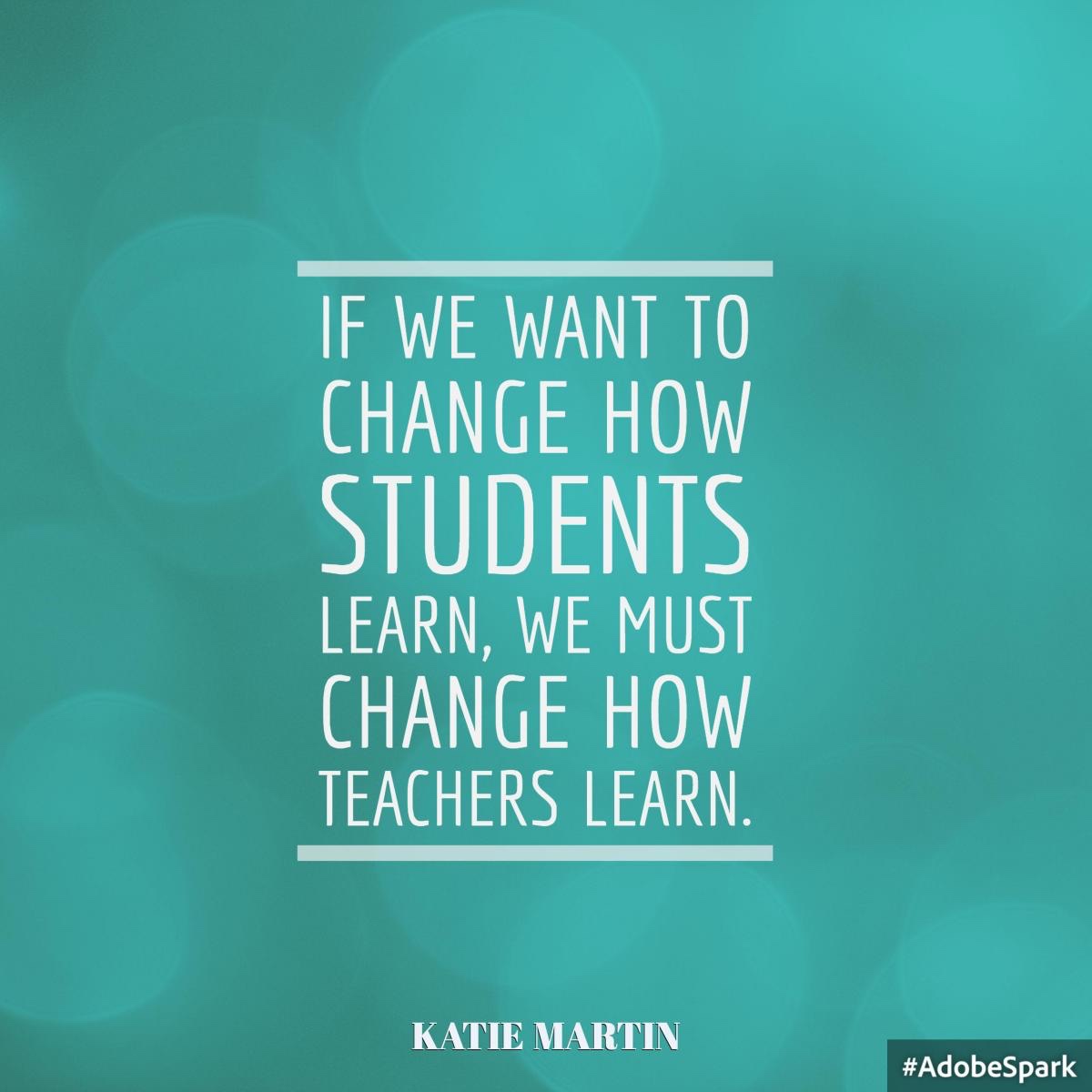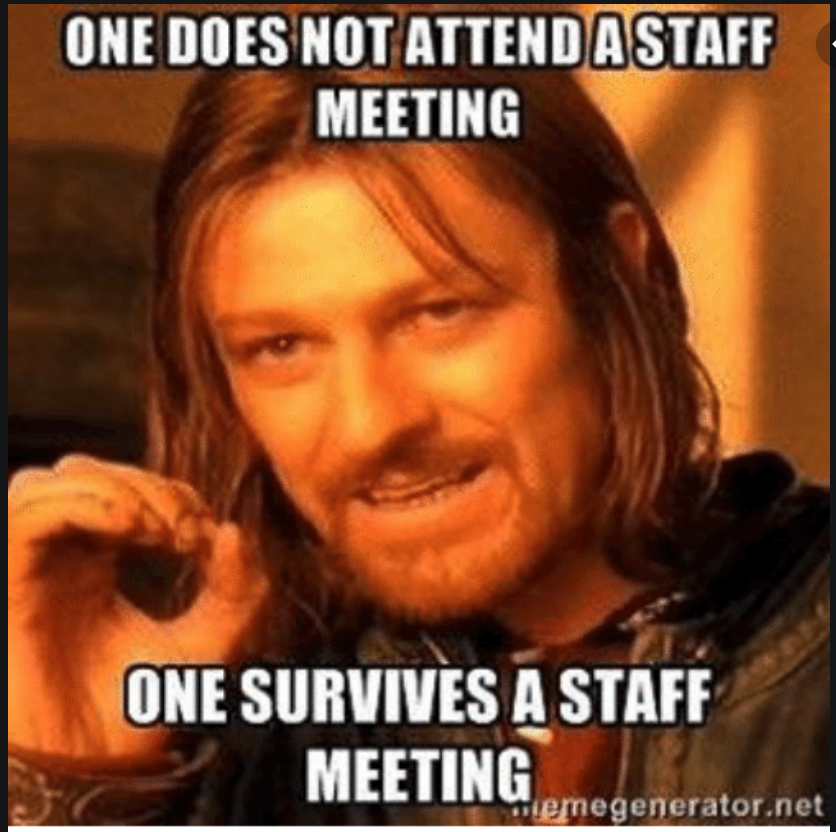The more a teacher knows about teaching and has opportunities to develop the fundamental skills to be an effective teacher, the more successful they will likely be in the classroom. One of the biggest challenges and also one of the biggest opportunities for professional learning are staff meetings. It is easy to get caught up in logistics, new programs, pacing guides and cover all the things, but that rarely translates to teachers new and better practices and takes up valuable time. Because of this, I often hear and read about common frustrations that lead to memes like this.
Common pitfalls of staff meetings are telling people how to teach rather than modeling how we want students to learn or many great strategies are shared without really having time to practice or plan for how they would integrate these ideas into their existing practice.
When the focus remains only on what we teach it often fails to change how we teach.
Instead of the traditional staff meeting, here are 10 strategies that you could use to create a culture of learning and collaboration that impacts collective efficacy and impact.
1.Talk about learning
This might sound like a no-brainer but I don’t think it happens nearly enough. What I have seen to be more powerful rather than just implementing programs is to understand what we want our students to be able to know and do and how we can best design learning experiences and contexts to develop the type of learners we value.
One of my favorite strategies to do this is to have people reflect on their own learning experiences and share commonalities. No matter how often we do this activity, or how diverse the crowd, the themes of both the conditions and the context remain pretty consistent.
2. Go on a scavenger hunt
When we talk about learning (and not just programs or logistics) we can go deeper and find examples of what it looks like. I love to set up scavenger hunts to find and celebrate examples of the desired practices in each of the classrooms. Instead of talking about it in staff meetings, your staff can grab phones and take pictures to document and share examples and ideas to take back to their classrooms. One you have pictures and or videos you can put together a montage for teachers to see the best examples of inquiry, communication, collaboration, critical thinking, and creativity (or whatever your focus is) that are evident throughout the campus. The video can both documented what is happening on campus and validate the progress; it was also a catalyst for growth. The focus on what is going well validates the hard work, creates opportunities for discussion, and prompts reflection about our own practice- both validating and stretching thinking.
3. Engage in a book study
Just as book clubs for students can be aligned according to a common theme to allow for more personal choice, the same format works for educators.
I love doing book studies to allow for choice in what educators read and opportunities to learn in group that are interested in similar topics. Having a common “anchor text” to read and discuss can be helpful for educators to learn about new and ideas and they can collaborate during your staff meetings to discuss how to implement them in your own context. You can use your staff meetings for conversation on selected questions or topics or allow for educators to share out big ideas that they are learning across books.
4. Work together to solve problems
An inquiry-based approach to learning and improvement aims to engage learners in rapid cycles of Plan, Do, Study, and Act (PDSA) to learn fast through action, fail fast, and improve quickly. This approach acknowledges that failure is part of the process and that failure itself is not the problem; failing to learn from the process is where we can go wrong. Inquiry based professional learning empowers learners to make tweaks as they investigate ideas. For educators, this model of discovery, exploration, and doing allows us to continually improve the way we serve the learners in our specific context. Learning to better understand the challenges I am facing and then generating and testing new ideas has allowed me to own my learning and has provided me with a sense of agency. It is so empowering to see the results that come from putting what you are discovering into practice!
5. Look at student work
In my experience, one of the best ways to understand and provide feedback to improve teaching and learning is to look at student work samples from your own projects. When educators look collectively at student work to determine strengths and implications for designing learning experiences, we can learn a great deal about our impact on desired learning outcomes and discover ways to improve.
6. Share something that worked (and talk about how more people can do it)
Overwhelmingly, teachers prefer to learn from and with their peers, and we all benefit from regular collaborative learning opportunities with others. Put effective systems in place for teachers to connect and collaborate during your staff meeting so they can share what is working and learn new strategies and increase their effectiveness and efficacy through the collective knowledge and support of the learning community.
7. Share something that failed (and get feedback on how to improve)
Presenting challenges, providing feedback, and creating actionable next steps are all valuable exercises that help improve learning experiences. Teachers can benefit from presenting a lesson idea or project on which they are just beginning to hear feedback. Midway through a project, you can seek feedback to help improve and determine next steps, or at the end to improve for next time. I love using the School reform Institute Consultancy Protocol to do this. “All dilemmas have some sort of identifiable tension in them. Sometimes the dilemma will include samples of student or adult work that illustrate it, but often the dilemma crosses over many parts of the educational process.” Spending time in staff meetings discussing dilemmas or challenges can help get multiple perspectives to navigate the path forward.
8. Learn something new
Creating structured opportunities to be metacognitive about how and what you are learning can inspire the creation of new learning experiences for students. Throughout Design Challenges, teachers began to empathize with learners and the learning process and see the value of the vast resources online as well as the variety of opportunities that exist for learning. Most importantly, they see the possibilities for their own students and are able to imagine ways to bring those learner-centered experiences to their classrooms.
Try these Design Challenges
9. Conduct empathy interviews- interview kids, families, community members, colleagues, school staff
To better understand the context and empathize with learners or your community, empathy interviews can be a powerful process. When you gather insight about the experience and perceptions of others you can deepen your understanding of how to better design lessons and experiences to meet the needs of learners. You can bring in students or use PLC time to conduct thirty-minute interviews.
Here are some basic questions:
- What is school like for you?
- Do you feel valued? By Whom?
- When do you feel successful inside the classroom?
- When have you felt unsuccessful?
- How might you improve this school?
In one-on-one or small-group settings and by asking open-ended questions and intentionally listening more than talking, you can learn a lot about your students.
10. Teach each other
Teachers spend all day teaching students but rarely get to share this expertise with their colleagues. Carve out time in each staff meeting for educators to pick something that they want to teach the rest of the staff. If everyone is responsible for sharing something and doing a 4-5 minute quick share, think of all that you could learn and the connections that you could make! Shout out to Jon Corippo and Pam Hernandez for modeling this with superintendents this week at SuperCUE. Each superintendent prepared a 4 minutes presentation to share with their colleagues. It was awesome to learn from what each of them had to share!

For more strategies and resources, check out a free preview of Learner-Centered Innovation.



0 Comments